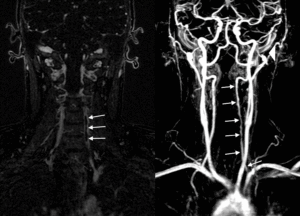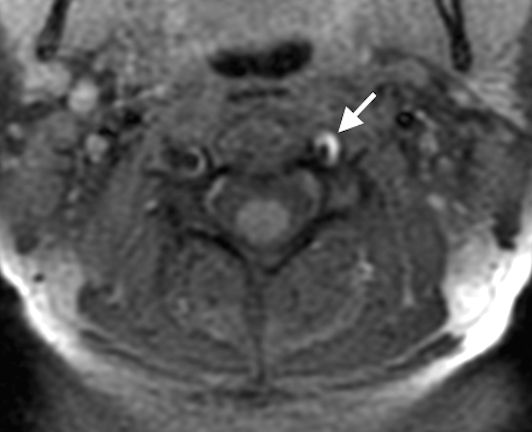Recognition of Vertebral Artery Dissection in a High-Risk Postpartum Patient by a Chiropractic Physician
Written by: James Demetrious, DC, DABCO
Introduction
Vertebral artery dissection (VAD) is an uncommon yet potentially catastrophic vascular event that often eludes timely recognition. Its presentation may mimic benign conditions, and when diagnosis is delayed, patients remain at risk of ischemic stroke. A recent case I diagnosed underscores the indispensable role of chiropractic physicians in identifying subtle but significant warning signs through careful history, symptom analysis, and timely referral for advanced imaging.
Cervical artery dissection is a leading cause of stroke in young and middle-aged adults. Its early symptoms, headache, posterior neck pain, dizziness, or visual changes are nonspecific, and clinicians may misattribute them to migraine, musculoskeletal strain, or postpartum complications. The literature reports a mean diagnostic delay of nearly 10 days, during which patients remain vulnerable to spontaneous thromboembolic events.
In the featured case, a postpartum woman with connective tissue disease and preeclampsia developed severe occipital headache, posterior neck pain, and neurological complaints. Initial emergency and inpatient evaluations identified carotid artery aneurysms and attributed symptoms to preeclampsia, but crucially, vascular imaging of the neck was not performed. The diagnosis of VAD remained unrecognized until chiropractic consultation nearly two weeks later.
Chiropractic Recognition and the Power of History
When the patient later sought a telehealth consultation with an out-of-state chiropractic physician, the history provided by the patient and her mother revealed a clear temporal progression of symptoms:
-
Sudden, severe posterior cervical pain and headache.
-
Persistent neurological symptoms despite treatment of preeclampsia.
-
Visual disturbances, lightheadedness, cognitive clouding and gait abnormality suggestive of posterior circulation ischemia.
This comprehensive recounting of her symptom evolution raised immediate suspicion for vertebral artery dissection. The chiropractor recommended urgent neck MRA, which confirmed a long-segment left vertebral artery dissection with intramural hematoma (See Figure 1). Timely initiation of antithrombotic therapy prevented stroke and facilitated recovery.

Figure 1. Long segment V2 VAD dissection.
This case illustrates how a meticulous patient history, combined with pattern recognition of red flag symptoms can redirect the diagnostic process. Importantly, it highlights the chiropractor’s role in recognizing when routine explanations fail and a vascular emergency must be ruled out.
Lessons in Clinical Diligence
Several clinical lessons emerge:
-
History is paramount. The progression of pain, presence of neurological complaints, and persistence of symptoms despite initial treatment should heighten suspicion for vascular pathology.
-
Do not anchor prematurely. While postpartum preeclampsia explained some findings, continued neurologic symptoms warranted further exploration.
-
Neck imaging matters. Brain-only imaging may miss posterior circulation pathology. When symptoms implicate the vertebrobasilar system, cervical MRA or CTA must be obtained.
-
Chiropractic vigilance saves lives. Chiropractors frequently encounter patients with head and neck pain. By maintaining a high index of suspicion and advocating for appropriate imaging, they may prevent stroke through timely referral.
Conclusion
Vertebral artery dissection remains a diagnostic challenge due to its nonspecific presentation and overlap with benign conditions. This case exemplifies how careful history-taking, clinical vigilance, and persistence in recognizing unrelieved or progressive symptoms can lead to life-saving diagnosis. Chiropractic clinicians, often on the frontlines of evaluating neck pain and headache, play a critical role in identifying unrecognized vascular events and ensuring patients receive appropriate follow-up.
The clinical pearl is clear: When symptoms don’t fit or fail to resolve, return to the history, broaden the differential, and pursue definitive vascular imaging. The cost of delay is stroke; the reward of vigilance is patient safety.
Reference
Disclosure
The information provided in this article and all PostGradDC coursework should not be considered standards of care. We offer this information for educational purposes only. This information is not intended to be a substitute for professional medical advice, diagnosis, or treatment. Always seek the advice of your physician or qualified healthcare provider with any questions you may have regarding medical conditions or treatment. Seek the opinion of your legal representative. Errors and omissions are unintended.
Conflict of Interest Statement
Dr. James Demetrious is a board-certified chiropractic orthopedist and the founder and owner of PostGradDC (PostGradDC.com), a privately operated provider of chiropractic continuing education. Dr. Demetrious is a member of the NCMIC Speakers’ Bureau. He develops and delivers postgraduate coursework on clinical examination, diagnosis, patient safety, and risk management, including content related to cervical artery dissection and informed consent.
Dr. Demetrious has published peer-reviewed research on these topics and provides consultation services to chiropractic physicians, attorneys, and professional organizations. This commentary was written independently and without external funding. While his educational and advocacy activities promote evidence-based chiropractic practice, the views expressed herein are his own and are based on interpretation of the current scientific literature.

PostGradDC offers advanced post-graduate chiropractic continuing education. Our founder, Dr. James Demetrious, is a distinguished board-certified chiropractic orthopedist, educator, author, and editor.
© 2025 – James Demetrious, DC, DABCO. Open Access. Unrestricted use, distribution, and reproduction are allowed in any medium, provided you give appropriate credit by citing the original author and source: Demetrious J. PostGradDC. Recognition of Vertebral Artery Dissection in a High-Risk Postpartum Patient by a Chiropractic Physician. PostGradDC.com; 2025.

